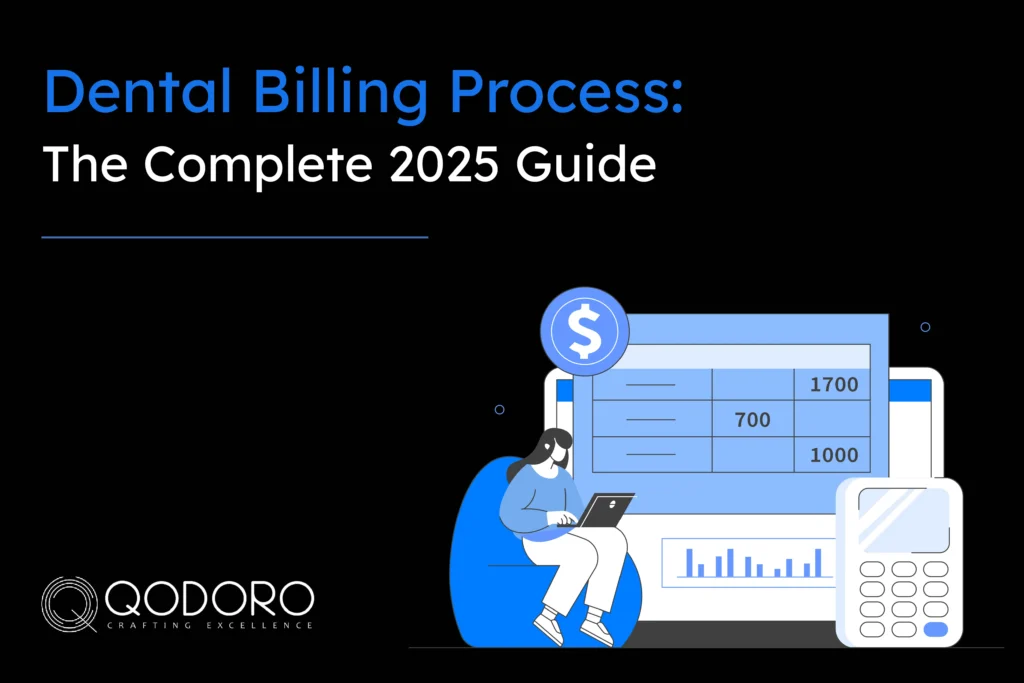
Published on: 18/06/2025

SHARE
Table Of Contents
Running a dental practice today isn’t just about providing excellent patient care, it’s also about ensuring that your operations are financially sustainable. At the heart of this is a well-organized dental billing process. But for many dental professionals, billing is where things get confusing, overwhelming, and at times frustrating.
In this comprehensive guide, we’ll walk you through every stage of the dental billing cycle, discuss best practices, common pitfalls, and how you can streamline your dental medical billing process for maximum efficiency and revenue recovery.
The dental billing process refers to the series of steps involved in submitting claims to insurance companies and collecting payments for dental services. It’s more than just filing forms, it’s about accuracy, compliance, communication, and follow-through.
While it may appear similar to general medical billing, dental billing comes with its own set of rules, coding systems, and insurance challenges. Unlike medical billing that often uses ICD and CPT codes, dental billing uses CDT (Current Dental Terminology) codes.
Understanding this process is crucial because even a small error can lead to claim denials, payment delays, or loss of revenue.
To manage your revenue effectively, you need to understand the dental billing cycle, which includes the following stages:
Before a patient receives treatment, collect complete personal, medical, and insurance information. Verifying their eligibility and benefits this step helps prevent coverage-related claim rejections later.
Once the diagnosis is made and the treatment plan is developed, it’s vital to use the correct CDT codes to reflect the procedures performed. This coding must align with clinical documentation and insurance requirements.
After coding, the claim is created and submitted to the insurance provider electronically or manually. Double-checking for errors before submission can greatly reduce claim rejections.
The insurance company processes the claim based on the patient’s plan. They may approve, deny, or ask for additional documentation. Keeping track of claim status is essential.
Once payment is received, it needs to be posted to the patient’s account. Any remaining balance, such as deductibles or uncovered services, is billed to the patient.
If claims are denied or underpaid, timely follow-up and appeals are necessary. This step ensures the practice gets paid for services rendered.
Even with the best efforts, dental practices often face issues in their dental medical billing process that can slow down payments and impact revenue.
One of the most common problems is using incorrect codes. If the CDT codes don’t match the treatment provided or if the diagnosis and procedure codes don’t align, insurance companies can deny the claim. Repeated mistakes like this can even trigger an audit.
Another big challenge is confusion around coverage. Many patients think their insurance covers everything, but that’s rarely the case. Things like pre-approvals, treatment limits, or exclusions can make billing more complicated. Without checking these details first, practices may end up doing work they don’t get paid for.
When a patient has more than one insurance plan, it’s important to figure out which one is primary. This is called Coordination of Benefits (COB). If the order is wrong, the claim can be delayed or denied.
Deadlines are also a big issue. Insurance companies have strict time limits for submitting claims. If the claim is filed late even if it’s completely correct the provider might not get paid at all.
Another problem is missing or incomplete documentation. If clinical notes, X-rays, or other required attachments are not submitted, the insurance company may delay or reject the claim. Good documentation supports claims and protects the practice in case of any future disputes.
These issues show how important it is to stay updated, follow clear systems, and train your team regularly. Dental billing isn’t just about sending claims it’s about doing it right, every step of the way.
Good dental billing practices can help your clinic get paid faster, avoid mistakes, and reduce stress for your team. Here are some simple tips that really work.
Start by verifying insurance before every visit. Even if the patient has been coming for years, their coverage might have changed. Always check their eligibility and benefits before the appointment to avoid surprises later.
Make sure you use the correct codes. CDT codes are updated every year, so it’s important to stay up to date. You can attend coding workshops or use dental software that updates the codes automatically.
Educate your patients about what’s covered and what’s not. Talk to them before the treatment and share a clear estimate of costs. This helps avoid confusion or arguments about the bill later.
Always submit clean claims. Double-check everything patient names, policy numbers, procedure codes, and modifiers before sending the claim. Even a small mistake can cause delays.
Don’t forget to follow up on claims. If you haven’t heard back from the insurance company in 15 to 30 days, check the status. The longer you wait, the harder it is to get paid.
Keep good records. Every treatment should be clearly documented with notes, X-rays, or images. This helps support your claims and protects your clinic if there’s ever a question or audit.
Finally, train your staff regularly. Insurance rules change often, and your team should always be up to date. A well-trained team means fewer mistakes and faster payments.
By following these simple and consistent steps, your dental billing process becomes smoother, and your clinic stays financially healthy.
If you want to make your dental billing process easier and faster, here are some simple steps you can follow.
First, use dental billing software. This software helps reduce mistakes, keeps patient records safe, sends claims to insurance companies, and shows you updates in real time. It saves you a lot of time and effort.
Next, connect your billing system with your patient management system. When your Electronic Health Records (EHR) and billing tools work together, you don’t have to enter the same information twice. This makes the process quicker and smoother.
It’s also helpful to track your billing numbers. Keep an eye on things like how many days it takes to get paid, how often claims are denied, and how much money is still waiting to come in. These numbers show where things are slowing down and where you can do better.
Another good idea is to make a billing checklist. This is a list your team can follow to make sure they do everything like filling out claims, adding the right documents, and following up on time. A checklist helps everyone stay on track.
Finally, talk to your patients before treatment. Ask them to sign forms and confirm they understand what they need to pay. When people know what to expect, it’s easier to collect payments later and avoid confusion.
By following these simple steps, you can make your dental billing cycle run smoothly, reduce errors, and get paid on time.
Not every practice has the bandwidth or expertise to manage billing in-house. If you’re struggling with frequent denials, late reimbursements, or administrative burnout, outsourcing could be the solution. Here’s when it makes sense to outsource:
If more than 10–15% of your insurance claims are getting denied, it’s a sign that something isn’t working. Denials can happen due to incorrect codes, missing documents, or filing errors. A professional billing team knows how to avoid these mistakes and improve your approval rate.
If your income goes up and down every month and you’re unsure how much money will come in, it’s hard to plan or grow your practice. Outsourcing can lead to faster claim processing and more regular payments, giving your practice more financial stability.
Your front desk team already has a lot to do answering calls, scheduling appointments, and handling patients. Adding billing responsibilities often stretches them too thin, leading to burnout and errors. Outsourcing lets your team focus on patient care while billing experts handle the paperwork.
Dental billing isn’t just about filling forms. It involves understanding CDT codes, insurance rules, and compliance regulations. If your in-house team isn’t trained in these areas, mistakes are likely. A dental billing company brings in the right expertise and stays updated on changes.
Hiring and training in-house billing staff can be expensive. While outsourcing has a cost, it often saves money in the long run by reducing claim denials, getting faster reimbursements, and lowering write-offs. You also don’t have to worry about staff turnover or training costs.
A well-run dental billing process is the backbone of a successful dental practice. From coding and claims to collections and compliance, each part of the cycle plays a role in keeping your business healthy.
By understanding the dental billing cycle, adopting best dental billing practices, and recognizing when to outsource, you can protect your revenue, reduce stress, and spend more time doing what you love caring for patients.
In today’s competitive and regulated landscape, smart billing isn’t optional, it’s essential. Start auditing your dental medical billing process today, and you’ll thank yourself tomorrow.
Medical billing uses ICD and CPT codes, while dental billing uses CDT codes. The insurance structures and rules also differ significantly.
It depends on the payer, but on average, claims are processed in 2–4 weeks if submitted correctly.
Outsourcing costs vary, but the ROI often comes from faster reimbursements, fewer denials, and reduced overhead.

